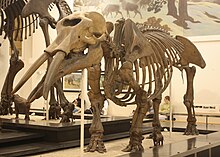
Back Gomphotheriidae Azerbaijani Gomfotèrids Catalan Gomphotherium German Gomphotheriidae Spanish گوهدد Persian Gomphotheriidae Finnish Gomphotheriidae French גומפותריומיים HE Gomphotheriidae Hungarian Gomphotheriidae ID
| Gomphothere Temporal range: Late Oligocene - Holocene
| |
|---|---|

| |
| Specimen of Gomphotherium productum at the American Museum of Natural History | |

| |
| Notiomastodon platensis Centro Cultural del Bicentenario de Santiago del Estero in Argentina | |
| Scientific classification | |
| Domain: | Eukaryota |
| Kingdom: | Animalia |
| Phylum: | Chordata |
| Class: | Mammalia |
| Order: | Proboscidea |
| Superfamily: | †Gomphotherioidea |
| Family: | †Gomphotheriidae (Hay, 1922) A. Cabrera 1929 |
| Genera | |
| |
Gomphotheres are an extinct group of proboscideans related to modern elephants. They were widespread across Afro-Eurasia and North America during the Miocene and Pliocene epochs and dispersed into South America during the Pleistocene as part of the Great American Interchange. Gomphotheres are a paraphyletic group that is ancestral to Elephantidae, which contains modern elephants, as well as Stegodontidae. While most famous forms such as Gomphotherium had long lower jaws with tusks, which is the ancestral condition for the group, some later members developed shortened (brevirostrine) lower jaws with either vestigial or no lower tusks, looking very similar to modern elephants, an example of parallel evolution, which outlasted the long-jawed gomphotheres. By the end of the Early Pleistocene, gomphotheres became extinct in Afro-Eurasia, with the last two genera, Cuvieronius ranging from southern North America to western South America, and Notiomastodon having a wide range over most of South America until the end of the Pleistocene around 12,000 years ago, when they became extinct following the arrival of humans.
The name "gomphothere" comes from Ancient Greek γόμφος (gómphos), "peg, pin; wedge; joint" plus θηρίον (theríon), "beast".
© MMXXIII Rich X Search. We shall prevail. All rights reserved. Rich X Search